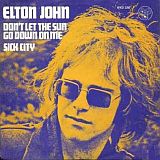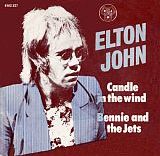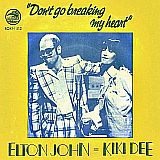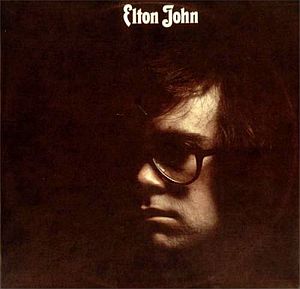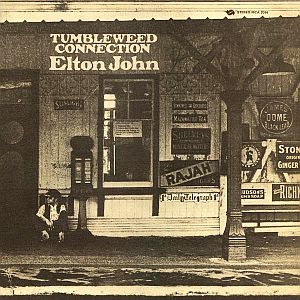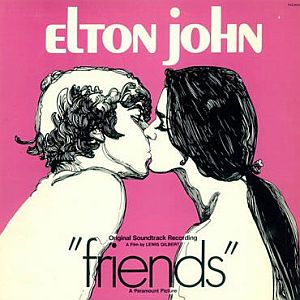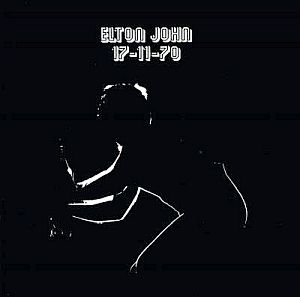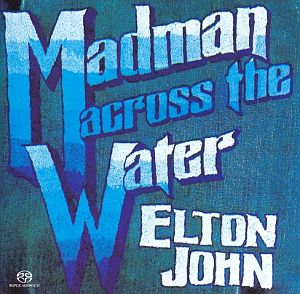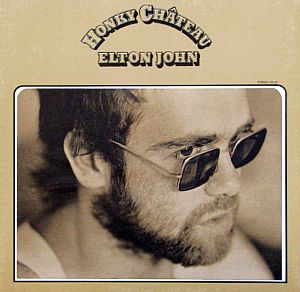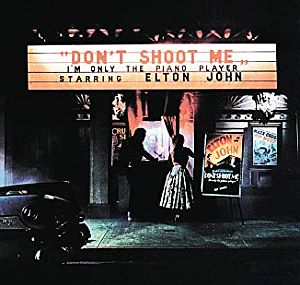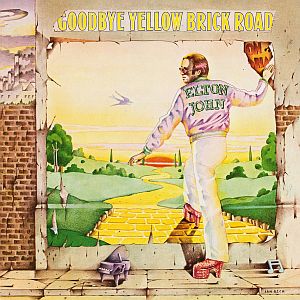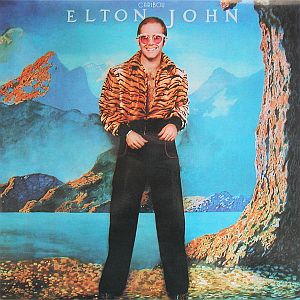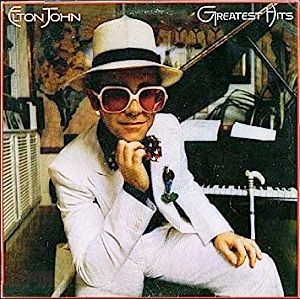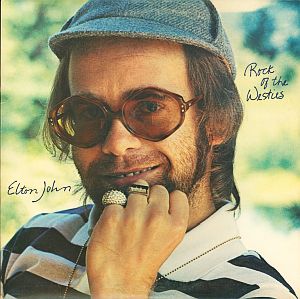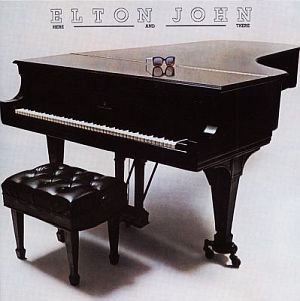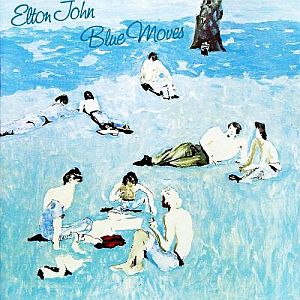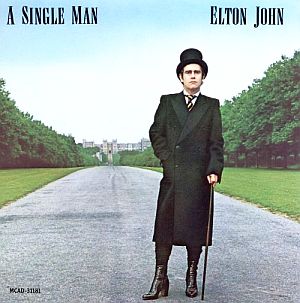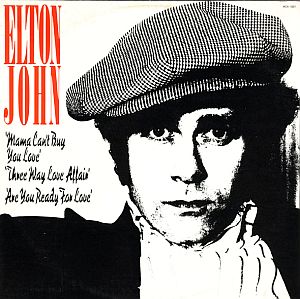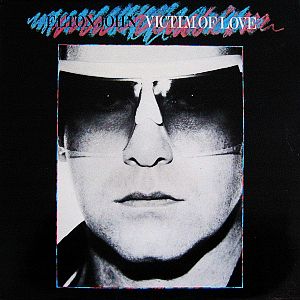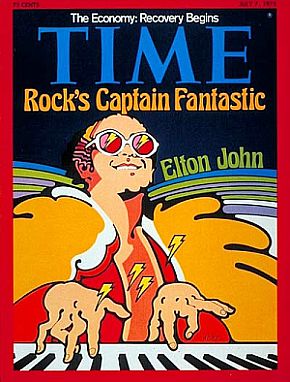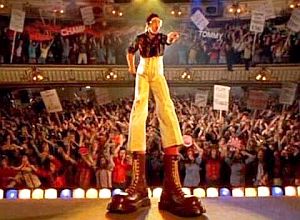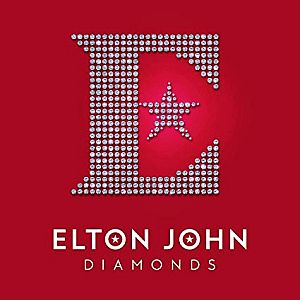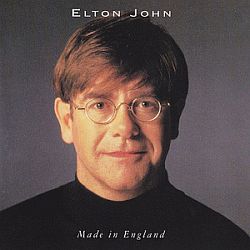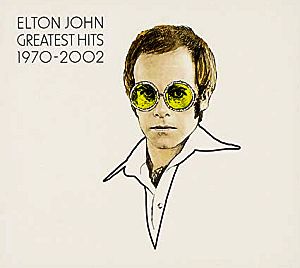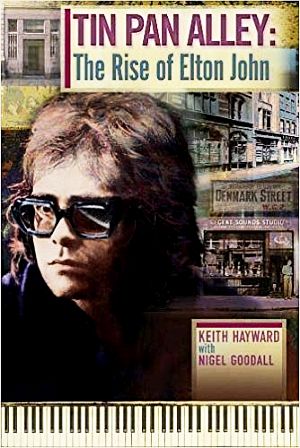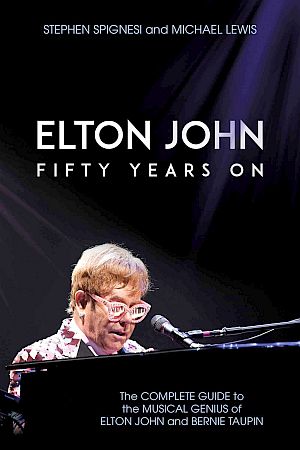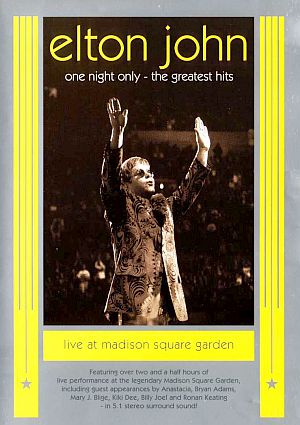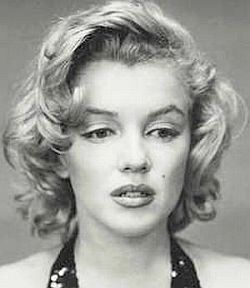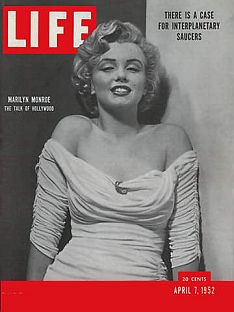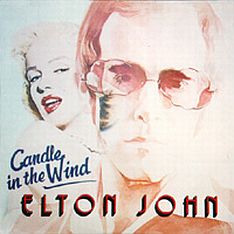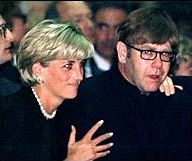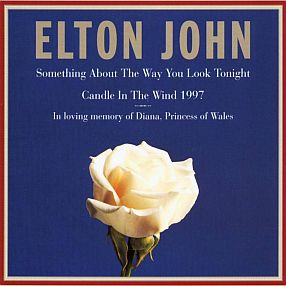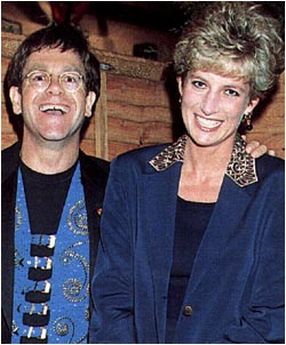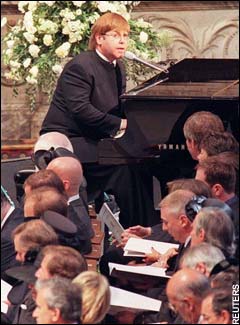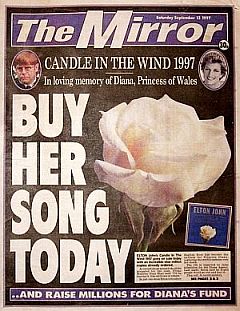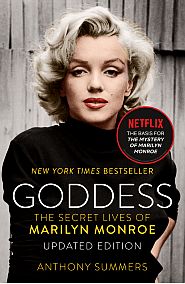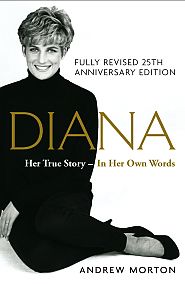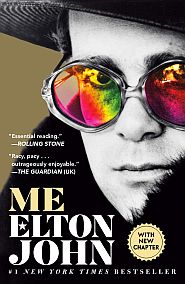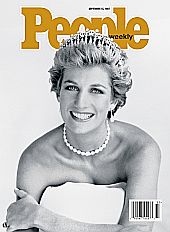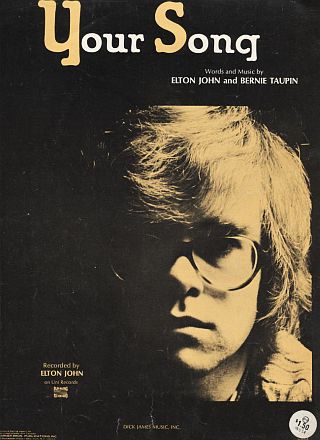
Sheet music cover for Elton John’s “Your Song,” one of his first Top Ten hits in the U.S., England, and Canada. Click for digital version.
Music Player
“Your Song” – 1970″
“Your Song” was a kickoff of sorts, the breakthrough song that sent Elton John and Bernie Taupin on their way to the big time. As The Rolling Stone Encyclopedia of Rock and Roll would say of the prolific output of John and Taupin in the 1970s:
“…For most of the `70s Elton John and lyricist Bernie Taupin were a virtual hit factory with 26 Top 40 hit singles, 16 Top 10, and six No.1 hits. Fifteen of the 19 albums released in the United States during this time went gold [500K] or platinum [1 million]. In the `80s their fortunes declined only slightly. To date [as of 2001] they have achieved more than four dozen top 40 hits and become one of the most successful songwriting teams in pop history…”
What follows later below is an Elton John chronology listing most of the major albums and singles turned out by the John/Taupin team in the 1970s – a decade significantly marked, if not dominated, by their music. As the Rock & Roll Hall of Fame has noted: “…John and Taupin identified and shaped the mood of the Seventies from its inception. Given to roughly equal numbers of ballads and rockers, John’s output was as critical to this decade as the Beatles were to the Sixties and Presley to the Fifties.” Before getting to the chronology, however, some background on John, Taupin, and the times.
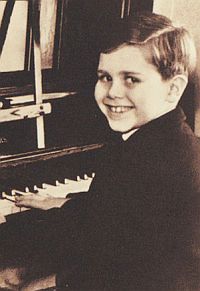
1950. Young Reggie at piano.
“Reggie” Dwight
Elton John was born Reginald Kenneth Dwight in a London suburb in March 1947. “Reggie,” as he was called growing up, learned to play piano at an early age, and was somewhat gifted with an ear for melody and could play classical pieces from memory.
John’s parents were fairly strict, with his father encouraging him to pursue a more conventional career. However, both parents were musically inclined and record collectors, among which were Bill Haley and Elvis Presley recordings that young Reggie liked most.
At the age of 11, Reggie won a junior scholarship to the Royal Academy of Music, where he attended Saturday morning sessions for several years. At school on occasion – presaging his later stage antics – Reggie would imitate the raucous piano style of rocker Jerry Lee Lewis. By age 15, he was playing piano in a local pub. In 1962 he formed a band named Bluesology, and two years later, dropped out of school to pursue music full time.
Bernie Taupin
By June 1967 John met his life-long songwriting partner, Bernie Taupin after both had separately answered the same magazine ad in the New Musical Express — an ad seeking songwriters. Taupin was born in 1950 at a farmhouse in eastern England, where he grew up, a somewhat rural area that would color his later lyrical life. Not a keen student, but having a flair for writing, Taupin at age 15 worked briefly in the print room of the local newspaper, The Lincolnshire Standard, with thoughts of possibly becoming a journalist. When that did not work out, he drifted through various part-time jobs until answering the New Musical Express ad for songwriters. He and John would prove to be an exceptionally productive pair, as Taupin could sometimes turn out lyrics in less than an hour, while John was equally efficient and would fit Taupin’s words to music without changing the lyrics. When the two first met in 1967, they recorded what would become the first Elton John/Bernie Taupin song: “Scarecrow”. Not long after, “Reggie” would begin using a new name – “Elton John” – which he would formally adopt later.
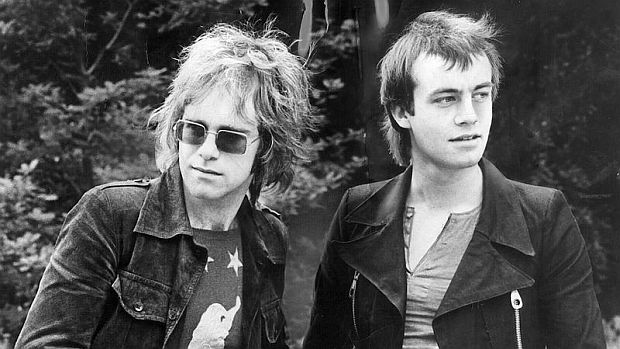
1970. Young collaborators, Elton John and Bernie Taupin, on the cusp of becoming one of the music industry’s most successful hit-producing teams.
Initially, John and Taupin wrote songs for Dick James Music for other artists, and John also worked as a session musician for groups such as the Hollies. John and Taupin, however, were advised to write for themselves, which they began doing in 1968, producing an early album titled Empty Sky. The album was recorded during the winter of 1968 and spring of 1969. It was released in the U.K. in early June 1969. However, neither it nor other early John-Taupin tunes were making much headway in the U.K. And that’s about when Dick James got the idea of sending Elton to America, which Elton initially resisted.
U.S. Breakout
The Troubadour
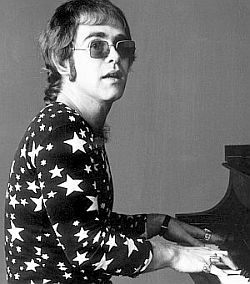
Young Elton John at piano, circa 1970, age 23.
Still, the album had been sent to a number of U.S. venues hoping to receive some U.S. exposure for the new British singer and piano player. Doug Weston, owner of the Troubadour nightclub in West Hollywood, Los Angeles was one of those receiving the album – along with a request for John to perform at his club. Weston, upon hearing the album, booked John for some late August shows.
The Troubadour by then was already well known for being a center for 1960s folk music and would help launch the careers of a long list of singer-songwriters and rock musicians. But Dick James’ sending Elton John to America in this case was actually something of a last attempt to get John’s music across to the public.
Meanwhile, a single from the Elton John album, “Border Song,” had made a modest entrance on the Billboard Hot 100 by the time of Elton’s first Troubadour show in late August 1970. Local FM radio had also been playing his songs leading up to the show. So there was a rising interest among musicians, music industry reps, and music critics leading up to his appearance on August 25, 1970.
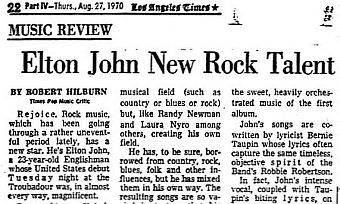
Robert Hilburn's review of Elton John’s opening show at the Troubadour, as it appeared, Los Angeles Times, Aug 27, 1970.
Also in the audience that night were Quincy Jones, Mike Love of The Beach Boys, David Crosby, Gordon Lightfoot, Leon Russell, Danny Hutton of Three Dog Night, Linda Ronstadt, and other notables.
John performed a nine-song set that night, leading off with “Your Song” followed by “Bad Side of the Moon,” “Sixty Years On,” “I Need You To Turn To,” “Border Song,” “Country Comfort,” “Take Me To the Pilot,” “Honky Tonk Woman” (a Rolling Stones cover), and “Burn Down the Mission.” Five of the songs were from the Elton John album, and two others from a later planned album.
John did not disappoint with his performance that night, as he received a rousing response from the audience (some years later, in 1990, Rolling Stone magazine declared these shows to be among the 20 most important concerts in the history of rock ‘n’ roll).
“Tuesday night at the Troubadour was just the beginning. He’s going to be one of Rock’s biggest and most important stars.”
– Robert Hilburn, L.A. Times In the next day’s Los Angeles Times, rock critic, Robert Hilburn, gave the show a rave review, opening with: “Rejoice. Rock music…has a new star. His name is Elton John, a 23-year old Englishman whose United States debut at the Troubadour… was, in almost every way, magnificent.” Hilburn reported that the crowd – including the largest local gathering of rock writers in months – “roared its approval, bringing John back for an encore.” Hilburn added that by the end of the evening: “there was no question about John’s talent and potential. Tuesday night at the Troubadour was just the beginning. He’s going to be one of Rock’s biggest and most important stars.”
Thereafter, it was “Katie bar the doors!” First, there was a brief U.S. tour following the Troubadour shows that ran from October 29th through December 4th. One of these shows at the A&R Studios in New York City was recorded for a later live album. Then, for the rest of the decade, the Elton John/Bernie Taupin mind-meld kicked in at full speed, turning out a continuing stream of hit albums and hit singles. (Click on any of the album or singles covers displayed below to visit respective Amazon.com pages).
A Decade of Hits
During 1971 alone, there were four new albums, each of which reached Billboard’s album chart – the western-themed Tumbleweed Connection; the soundtrack to an obscure film, Friends; the live album 11-17-70, recorded on that date at a New York radio station; and Madman Across the Water, which contained the hit singles “Tiny Dancer,” “Levon,” and the title track. Honky Chateau, which appeared in 1972, included hit singles “Honky Cat” and “Rocket Man.”
In fact, from 1972 to 1975, there would be seven consecutive albums that topped the charts: Honky Chateau (1972, No.1 for five weeks), Don’t Shoot Me, I’m Only the Piano Player (1973, No.1 for two weeks), Goodbye Yellow Brick Road (1973, No.1 for eight weeks), Caribou (1974, No.1 for four weeks), Elton John – Greatest Hits (1974, No. 1 for ten weeks), Captain Fantastic and the Brown Dirty Cowboy (1975, No.1 for seven weeks) and Rock of the Westies (1975, No. 1 for three weeks).
These seven albums topped the album chart for a combined total of 39 weeks, meaning that during the mid-1970s, Elton John had a No.1 album about every fourth week.
(See below: “An Elton John Chronology” for listing of album covers and more detail).
As for hit singles, according to the Rock and Roll Hall of Fame, during the three-year period 1973-1976, John amassed 15 hit singles in the U.S., including six that went to No.1 – “Crocodile Rock,” “Bennie and the Jets,” “Lucy in the Sky With Diamonds,” “Philadelphia Freedom,” “Island Girl,” “Don’t Go Breaking My Heart”. Three others were No. 2 hits – “Daniel,” “Goodbye Yellow Brick Road,” “Don’t Let the Sun Go Down on Me”.
Those 15 singles logged a combined 156 weeks from 1973-1976, which is to say that, on average, an Elton John single could be found in the Top 40 every week for three years.
What follows below is a general 1970s chronology of Elton John’s hit singles, albums, and a selection of a few other career highlights from that decade. To be sure, there is much more to John’s career beyond the 1970s, which stretches another 40 years through the 2010s to the present day. And some of the story for those years is covered below the chronology, where the narrative continues.
_____________________________________________
An Elton John Chronology
1970s Music & Other Events
(not a complete list)
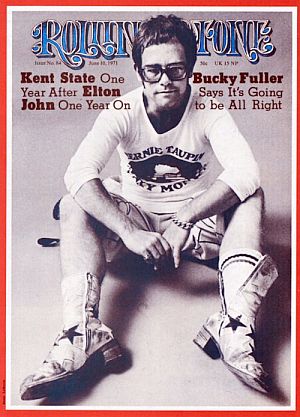 Rolling Stone, June 10, 1971, cover story, “Elton John: One Year On,” meaning one year from his breakout at the Troubadour. |
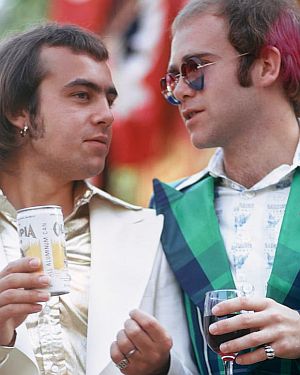 July 10, 1973. Bernie Taupin and Elton John enjoying their early success at a private Universal Studios party, Universal City, California. |
1969-1975
Elton John’s first studio album, Empty Sky, is produced in the U.K. and released there in 1969, but not in the U.S. until 1975.
10 April 1970
Elton John’s second studio album – titled Elton John – is released in the U.K., peaking at No. 5 and spending 22 weeks on that chart. In the U.S., it is John’s debut album, released there on July 22nd, peaking on Billboard at No. 4. It is also nominated for an Album of the Year Grammy. Some years later it would be inducted into the Grammy Hall of Fame.
24 April 1970
Release of “Border Song” single from Elton John album flopped in the UK, but later peaked in Canada at No. 34, John’s first chart appearance in any country. “Border Song” would also hit No. 92 on U.S. Billboard chart by Oct 1970.
25 August 1970
U.S. breakout after performance at Trouba-dour club in Los Angeles, CA; gets rave review in L.A Times.
30 October 1970
Tumbleweed Connection, 3rd studio album released in the U.K. on this date; U.S., January 1971; peaks at No. 2 in the U.K., No.5 on Billboard. On this album, John and Taupin were influenced by American country rockers, The Band and 1968’s Music From Big Pink, as well as western TV shows they grew up watching. No U.S. singles issued from this album, but “Come Down in Time,” sampled below, with its strings, harp, oboe, and horn, offers a quiet love song.
Music Player
“Come Down in Time”- John/Taupin
From Tumbleweed Connection
31 December 1970
During 1970, Elton John had performed at 71 concert venues or made other appearances.
23 January 1971
“Your Song” single – from Elton John album – reaches No.8 by this date. Began as the B-side to “Take Me to the Pilot” before radio DJs discovered its gold. Later added to the Grammy HOF (1998) and also ranked No. 137 on Rolling Stone 500.
5 March 1971
Friends film soundtrack album released – a pre-U.S. breakout John/Taupin project that nonetheless went Gold by April 1971. Also received 1972 Grammy nomination for Best Original Score for a Motion Picture
10 April 1971
“Friends” single from the Friends soundtrack hits No. 34 on Billboard at this date.
10 May 1971
First live album released – titled 17-11-70 – recorded at the A&R Studios in New York City, Nov 1970, during post-Troubadour U.S. tour. Also scored Top 40 rank on album charts.
5 November 1971
Madman Across the Water, 4th studio album released. While only reaching No. 41 on the UK charts, Madman did better in the U.S., peaking at No. 8 on Billboard and No. 10 on 1972 year-end list. It achieved Gold standing in Feb 1972, and $1 million in U.S. sales. By 1998, it was multi-Platinum in the U.S., with sales of more that 2 million units.
11 November 1971
John & band perform most of Madman album before a small studio audience at BBC-Television Centre in London for broadcast on April 29, 1972 edition of “Sounds For Saturday” show on BBC2.
31 December 1971
During 1971, Elton John had performed at 129 concerts or made other appearances.
5 February 1972
“Levon” single (from Madman) – a song about a yearning young boy seemingly stuck in a boring place but bound by family business or local convention – hits No. 24 on the U.S. Billboard chart and No. 6 on Canadian chart.
Music Player
“Tiny Dancer”- John/Taupin
From Madman Across The Water
7 February 1972
“Tiny Dancer” single (from Madman) is released – believed to be about Bernie Taupin’s wife at the time, Maxine Feibelman, who loved ballet and also did a bit of sewing for Elton. But there are also elements about the free-spirited California girls Taupin met on his 1970 visit there. While a Top 40 hit in several countries, the song got a second wind after being featured in the 2000 film, Almost Famous. Certified 3x Platinum in the U.S., April 2018, and Gold in the UK, August 2018, though not released there as a single.
3 March 1972
“Rocket Man” single released, from Honky Château album, rises to No. 2 in the U.K. and No. 6 in the U.S. Spends more than three months on both charts. The song uses space travel as a metaphor for spiritual isolation. Later certified 3x Platinum, U.S. and No. 245 on RS500. Taupin says he took inspiration from Ray Bradbury’s 1951 short story, The Rocket Man, which also features a lonely astronaut missing his family
Music Player
“Rocket Man”- John/Taupin
From Honky Château
19 May 1972
Honky Chateau album released; would rise to No. 1 on Billboard 200 and be ranked at No. 359 on RS 500.
23 September 1972
“Honky Cat” single from Honky Château album hits No. 8.
31 December 1972
During 1972, Elton John had performed at 92 concerts or made other appearances.
1973
Elton John and partners launch Rocket Records label, used mostly for other artists.
22 January 1973
Don’t Shoot Me, I’m Only the Piano Player album is released; second straight No. 1 album in U.S. Eventually goes 3× Platinum.
3 February 1973
“Crocodile Rock” single (from Don’t Shoot Me) became John’s first U.S. No. 1 single on this date, staying there for 3 weeks. Also No.1 in Canada (4 weeks), No 5 in UK. U.S. Gold by Feb 1973, Platinum, Sept 1995.
2 June 1973
“Daniel” single hits No. 2 on Billboard by this date. Taupin wrote “Daniel” after reading a newsmagazine article about Vietnam War veteran who had been wounded and wanted to get away from the attention he was receiving when he went back home. “I wanted to write something that was sympathetic to the people that came home,” Taupin would later say
16 July 1973
“Saturday Night’s Alright For Fighting” single released (from Yellow Brick Road ); hits No. 7 on UK charts, No. 12 on Billboard. Also featured in Grand Theft Auto V video game (2013-14) and film, Kingsman: The Golden Circle (2017).
5 October 1973
Goodbye Yellow Brick Road double album released, reaches No.1, and remains on the album charts for two years. Using Wizard of Oz film imagery, the album is regarded as John’s best. It has sold more than 30 million copies worldwide. In 2000, Q magazine listed it at No.84 on its 100 Greatest British Albums Ever, and in 2003, it was inducted into the Grammy Hall of Fame and also ranked No. 91 on RS 500.
8 December 1973
“Goodbye Yellow Brick Road” single hits No. 1 Canada, No. 2 in U.S., No. 6 in UK. Song is widely praised by critics; some calling it John’s best song. Yellow brick road imagery from 1939 Wizard of Oz film used by Taupin to “get back to [his] roots.” Certified Platinum in 1995 (song sampled later, near end).
31 December 1973
During 1973, Elton John had performed at 91 concerts or made other appearances.
4 February 1974
“Candle in the Wind” (from Yellow Brick Road) – John/Taupin ode to departed Hollywood starlet, Marilyn Monroe – is released in U.K., reaches No. 11 there but is not released as a single in the U.S. (Click for separate story).
13 April 1974
“Bennie and the Jets”(from Yellow Brick Road) – a song about a fictional band and satire on the greed and glitz of the early 1970s music scene – hits No. 1 in U.S. after heavy play on CKLW radio in Windsor, Ontario, sending song to No. 1 in Detroit, as other markets followed. “Bennie” also found some acceptance on Top 40 R&B radio, especially after John appeared on the Soul Train TV dance show in May 1975 performing the song.
28 June 1974
John’s 8th studio album, Caribou, is his fourth No.1 album in the U.S. and third in the U.K.; nominated for Album-of-the-Year Grammy (1974) and certified 2x Platinum by 1993. The Caribou album is named for the Caribou Ranch studio, where it was recorded, in the Rocky Mountains near Nederland, Colorado, built in 1972. John also recorded the single, “Lucy in the Sky with Diamonds” there, along with its b-side, John Lennon’s “One Day (At A Time).” His next two albums were recorded there as well – Captain Fantastic… and Rock of the Westies, along with part of the single, “Philadelphia Freedom.”
27 July 1974
By this date, “Don’t Let the Sun Go Down on Me” single (from Caribou) has hit No. 2; song also features Beach Boys Carl Wilson and Bruce Johnston on backing vocals.
3 November 1974
“The Bitch is Back” single (also from Caribou) hits No.1 in Canada, 4 U.S., 15 U.K. RIAA Gold by Sept 1995. Reportedly, title was inspired by Taupin’s wife at the time, Maxine Feibelman, who would say, “the bitch is back,” when John was in a foul mood. Taupin lyrics also parody John’s celebrity lifestyle. Some radio stations in the U.S. refused to play the song because of the word “bitch,” to which John remarked: “some radio stations in America are more puritanical than others.”
8 November 1974
Elton John’s Greatest Hits album is released, his first “best of” compilation. It became a No 1 album in both the U.S. (10 wks) and the U.K. (11 wks). In 1975, it was the best-selling album in the U.S., and to date is one of John’s best-selling albums and among best-selling albums of all time, with 24 million copies sold worldwide.
28 November 1974
Thanksgiving Day; John coaxes former Beatle John Lennon onstage for three songs during a Madison Square Garden concert that turned out to be Lennon’s final live public performance.
1974
Elton John signs $8 million deal with MCA – company then reportedly took out a $25 million life insurance policy on John.
31 December 1974
During 1974, Elton John had performed at 69 concerts or made other appearances.
4 January 1975
Elton John cover of Beatles’ “Lucy in the Sky With Diamonds” hits No. 1 (w/John Lennon on guitar).
12 April 1975
“Philadelphia Freedom,” a non-album single, hits No.1 The song was inspired by John’s friendship with tennis superstar Billie Jean King, whose pro team at the time was the Philadelphia Freedoms.
Music Player
“Someone Saved My Life Tonight”
John/Taupin, from Captain Fantastic…
19 May 1975
Captain Fantastic and the Brown Dirt Cowboy album released, described as an autobiographical account of the early musical careers of Elton John (Captain Fantastic) and Bernie Taupin (Brown Dirt Cowboy). It debuted at No. 1 on the U.S. Billboard 200, believed to be the first album to do so. It sold 1.4 million copies in its first 4 days of release, and stayed at No. 1 for seven weeks
9 August 1975
Elton John named outstanding rock personality of the year at first Rock Music Awards in Santa Monica, California.
16 August 1975
“Someone Saved My Life Tonight” hits No. 4 on Billboard chart – the only single released from Captain Fantastic album. The song is a semi-autobiographical story of John’s ill-fated engagement to Linda Woodrow and his related suicide attempt, as the saving “someone” in the song – Bluesology bandmate and friend, Long John Baldry – convinced him to break off the engagement rather than ruin his music career for an unhappy marriage. John’s performance and piano are perfect in the story-telling, supported with a fine use of backing vocals throughout.
September 1975
“Amoreena,” a song about a young man’s love interest, from John’s 1970 Tumbleweed Connection album, is used over the opening credits of the Al Pacino film, Dog Day Afternoon. The song features John’s powerful piano playing and has a country-rock style from the 1970 Tumbleweed album.
Music Player
“Amoreena”- John/Taupin, 1970
From Tumbleweed Connection
11 October 1975
Neil Sedaka’s “Bad Blood” (on Rocket Records) hits No.1 and features John on harmony vocals.
24 October 1975
Rock of the Westies album enters Billboard chart at No.1 (second in a row to do that in the same year, then unprecedented), and is John’s seventh consecutive No. 1 album. The title is a play on the phrase “West of the Rockies,” as it was recorded at Caribou Ranch studio in the Colorado Rockies. RIAA-certified gold in October 1975 and platinum in March 1993.
25-26 October 1975
Elton John performs two sold-out shows at Dodger Stadium in Los Angeles (55,000 each night). It was part of his “West of the Rockies” tour that included 17 shows across the U.S. and Canada.
October 1975
Elton John becomes the 1,662nd person to receive a star on the Hollywood Walk of Fame.
1 November 1975
“Island Girl,” from Rock of the Westies album hits No.1.
31 December 1975
During 1975, Elton John had performed at 28 concerts or made other appearances.
1976
John, a long-time English soccer/football fan, becomes investor in, and director of, the professional Watford Football Club.
30 April 1976
Here and There live album released; title refers to two concerts: “Here,” a concert at London’s Royal Festival Hall, summer of 1974; and “There,” a concert at New York City’s Madison Square Garden, November 28 1974.
7 August 1976
“Don’t Go Breaking My Heart,” by Elton John and Kiki Dee, tops the U.S. charts for the first of four weeks. Released in June, it also rose to the top of the U.K. charts after three weeks. It was John’s sixth No. 1 hit in 3 years – and his last one in the U.S. for 21 years.
22 October 1976
Blue Moves album released; second double album and first on his own label, Rocket Records. Peaks at No. 3 in U.K. and U.S. Although album suffered some negative reviews – one finding it “impossibly weepy” and another charging “fatigue” – it was still RIAA-certified Gold (Oct 1976) and Platinum (Dec 1976). Includes Edith Piaf tribute song, “Cage the Songbird.”
Music Player
“Sorry Seems To Be The Hardest Word”
1976
25 December 1976
“Sorry Seems To Be The Hardest Word” single (from Blue Moves album), a ballad about a dying relationship, went to No. 3 in Canada., No. 6 U.S., and No. 11 U.K. – and No. 1 on the U.S. Easy Listening chart. The song was also used in 1977 film Slap Shot starring Paul Newman.
31 December 1976
During 1976, Elton John had performed at 64 concerts or made other appearances.
13 September 1977
Greatest Hits Volume II album is released. Would reach No. 6 in U.K., No. 21 on Billboard, and was certified Gold in September 1977, Platinum in November 1977. There have been several versions of the album.
3 November 1977
Elton John announces at a London concert that he is retiring from live performances, which he does – for 15 months.
31 December 1977
During 1977, Elton John had performed at 13 concerts or made other appearances.
1 October 1978
A Single Man album is released, reaching No. 8 in the U.K. and No. 15 on Billboard. It is Elton John’s 12th studio album and the first with Gary Osborne replacing Bernie Taupin as lyricist. It is the only Elton John album not have any tracks co-written by Bernie Taupin on the original cut. Still, in the U.S., even with mixed reviews, A Single Man was certified Gold in October 1978 and Platinum the following month.
31 December 1978
During 1978, Elton John had performed at 126 concerts or made other appearances.
3 February 1979
Elton John resumes touring after a 15-month hiatus.
21-28 May 1979
Elton John plays eight concerts in the former Soviet Union (USSR). The two-city tour – Leningrad and Moscow – was a significant event amid Cold War tensions of that era and one of the first rock concerts permitted there by a western artist. As a result of John’s visit, in June 1979, the Soviet authorities permitted the state-owned Melodiya record company to issue John’s 1978 album A Single Man, making it the first Western pop album to be officially released in the USSR
June 1979
An EP recording with three songs – The Thom Bell Sessions – is released. It was recorded by Elton John in 1977 in a project with R&B songwriter and producer, Thom Bell, known at the time for his Philadelphia soul music. One of the songs – “Mama Can’t Buy You Love” – became an Elton John Top Ten U.S. single, August 1979. Ten years later, The Complete Thom Bell Sessions was released by MCA, with the original six songs recorded by John and Bell.
13 October 1979
Victim of Love album released: hits No 35 on
Billboard, No. 41 in the U.K.
_____________________________________________
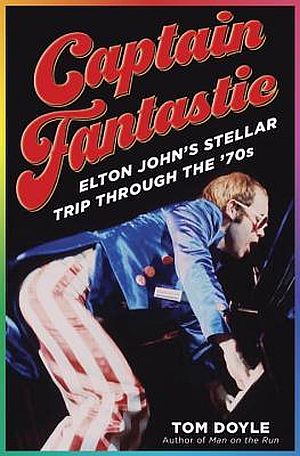
2017 book, “Captain Fantastic: Elton John’s Stellar Trip Through the ’70s,” by Tom Doyle (no relation). Click for copy.
The Showman
Part of the Elton John success machine of the 1970s evolved from his on-stage concert showmanship and flamboyant costuming.
At the piano, John was an energetic performer, often conducting Jerry Lew Lewis- type acrobatics, beginning with kicking the piano stool out of the way, playing the piano from various contorted positions, to doing flying handstands and horizontal extensions from the piano keyboard – revving up the audience as he did.
In terms of costumes, he used a range of glittery and feathered ensembles, platform shoes, eyeglasses, and more to adorn various fictional and on-stage musical personas. He not only entertained as a talented musician but also broke ground as a kind of “glam rock” fashionista, typically surprising his audience with some new outfit at every show.
As The Rolling Stone Encyclopedia of Rock & Roll has noted:
“In the mid-1970s, John’s concerts filled arenas and stadiums worldwide. He was the hottest act in rock & roll. And his extravagance, including a $40,000 collection of custom-designed and determinedly ridiculous eyeglasses and an array of equally outrageous stagewear, seemed positively charming.”
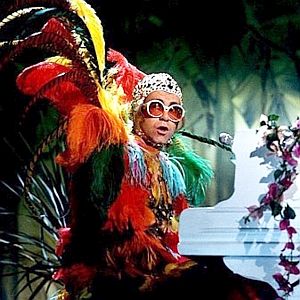
1977. Elton John amid colorful feathers on The Muppet Show.
At concerts he would appear in elaborate costume as the Statue of Liberty, Donald Duck, Wolfgang Amadeus Mozart, and other figures. He also appeared with an exaggerated Mohawk hair piece, in a bumble bee costume, as a cowboy, or in various feathered and floral arrangements.
In an appearance on The Muppet Show in June 1977, he wore a large Mummers-parade styled multi-colored floral and feathered ensemble with jeweled white skull cap and matching white-rimed and tinted sunglasses.
He would also dress up for special occasions, as in October 1975, when he received a star on the Hollywood Walk of Fame in Los Angeles, then wearing a special custom-made pale green and white suit with miniature, gold “Elton John sidewalk stars” sewn throughout the jacket, along with matching star-shaped eyeglasses. In 1997, at his 50th birthday party – for 500 friends – he costumed as Louis XIV of France.
Some of his concerts had an air of spectacle to them – as at the Hollywood Bowl in September 1975 where, as introduction, a succession of dressed impersonators of the Queen of England, Elvis Presley, Frankenstein, the Pope, the Beatles, Batman and Robin, Groucho Marx and Mae West all made their entrance down the staircase. Then, a set of concert pianos arrayed there each raised their covers to display a giant series of letters spelling out E-L-T-O-N, and as they did, flocks of doves were released.
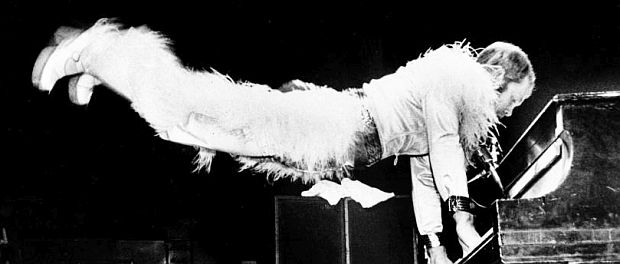
Elton John in concert during the 1970s, doing one of his flying handstands, extending out from the piano keyboard, typically revving up the audience with his energetic performances.
But there were also concerts where the music was what the fans remembered. In October 1975 at Dodger Stadium in Los Angeles– in a white and blue Dodger-like baseball outfit, adorned with silver studs along with a pair of rhinestone-encrusted glasses – he performed 3-hour plus shows before 100,000 raving fans over two nights. It was one of his more successful outings. Elton John was then a pop culture phenom, as photographer Terry O’Neill has observed:
…You have to remember – in October 1975, no one was bigger than Elton John. He was like Elvis at the height of his career. It is impossible to try to explain to people today what it was like – numerous number one albums, touring non-stop, recording non-stop, media, press, television… he was everywhere. Elton still is one of the most talented people I’ve ever met and he gave his all at those concerts.
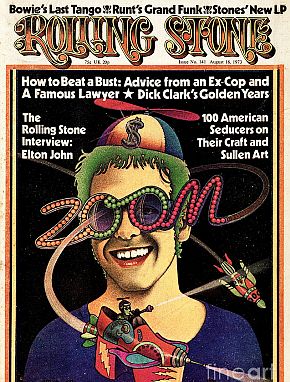 August 1973: Elton John featured on the cover of Rolling Stone with some of his decorative eyewear. |
Over more than 50 years, Elton John would play some 3,000 concerts in more than 75 countries around the world – and he’s not done yet, as his farewell tour with 300 more dates is slated to close in 2020.
Among other memorable Elton John imagery from the mid-1970s was his appearance as the pinball wizard of the famous Who song and rock opera album, Tommy – in the 1975 rock opera film of that name. John appeared as a very tall “Pinball Wizard” rigged on stilted giant boots.
Pete Townshend of British rock group, The Who, had asked John to play the “Pinball Wizard” character in the film version of the rock opera Tommy, and to perform the “Pinball Wizard” song.John’s version of the song was recorded and used for the movie release in 1975 and a single of the song was later released as well, charting at No. 7 in England. John’s version of that song is the only cover of a Who song to reach the Top 10.
The Bally Company, meanwhile, later released a “Captain Fantastic”-themed pinball machine featuring an illustration of Elton John on the machine’s main glass facing.
Living Large
Through the 1970s and 1980s Elton John soared to the top of the rock world. He played the most famous venues, became a media darling, and made millions of dollars. He also began living large as the good times flowed – “sex, drugs, and rock & roll,” as they say. But behind the success and flamboyance there were some real-life consequences that caught up with John by mid-career.
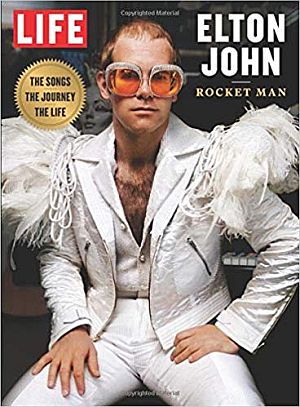
May 2019. Life special edition: “Elton John, Rocket Man: The Songs, The Journey, The Life,” Click for copy.
“Success was fantastic and then I couldn’t cope with it,” John explained in one interview about the film and his life, including his personal struggles, which he said he didn’t want covered up or glossed over in the film. “[Y]ou can’t leave out the bad,” he said, of those parts which are included in the film.
“Everyone knows I had quite a lot of [sex and drugs] during the ’70s and ’80s,” he explained during a May 2019 interview in The Guardian. “So there didn’t seem to be much point in making a movie that implied that after every gig, I’d quietly gone back to my hotel room with only a glass of warm milk and the Gideon’s Bible for company.”
Still, those scenes are painful for John. “…It’s difficult to watch [them in the film] because I thought, ‘God, I don’t want to go back there. Thank God I came out of it.”
In earlier interviews, John has spoken about his past excesses and his struggles with alcohol, drugs and food:
“I would have an epileptic seizure and turn blue, and people would find me on the floor and put me to bed. Then 40 minutes later I’d be snorting another line [of cocaine]…This is how bleak it was, I’d stay up, I’d smoke joints, I’d drink a bottle of Johnnie Walker and then I’d stay up for three days….I’d binge and have three bacon sandwiches, a pot of ice cream and then I’d throw it up because I became bulimic. And then go and do the whole thing all over again. That is how tragic my life was.”
“This is Elton John circa the late 1980s,” adds Time magazine, also reviewing Rocketman. “He may be one of the world’s richest and most successful rock stars, but he’s also an alcoholic, a cocaine addict and a bulimic. He’s addicted to sex and he has an anger-management problem. He loves prescription painkillers and he can’t stop shopping. He’s alternately agitated and demonically animated as he rattles off his list of flaws and vexations.” By the 1990s, John got treatment, pulled through it all, and got his head on straight.

Poster for 2019 film, "Rocketman," about the life and career of British rock star, Elton John, here recreating a scene from a famous October 1975 concert before tens of thousands at Dodger Stadium in Los Angeles. Click for "Rocketman" film DVD.
John also struggled with his sexuality for much of his career – married once, announced he was bisexual, then homosexual. Openly gay since 1988, he met David Furnish in 1993, a former advertising executive from Toronto, and the two began a relationship. They entered into a civil partnership in December 2005, and after same-sex marriage became legal in England and Wales, they married in December 2014. Today they have two young children born with the help of a surrogate mother.
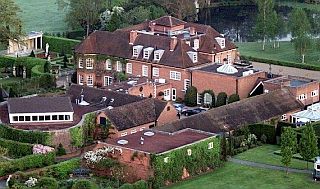 Woodside, the residence of Elton John in England since 1975. |
 Condo-converted to art gallery in Atlanta as part of Elton John residence there. Photo, Architectural Digest. |
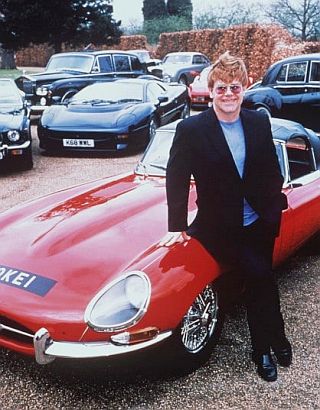 Elton John with some of his car collection, circa 2001. |
Wealth & Generosity
With his rapidly rising success in the 1970s, wealth came quickly to Elton John – and continued to come to him over the next four decades with touring, more hit songs, film and stage productions, Las Vegas performing, and legacy publishing fees and royalties.
In recent years, his personal wealth has been estimated in the $250-$400 million range. A few higher estimates have been closer to $500 million. Bernie Taupin, meanwhile, is believed to have amassed an estimated $70 million fortune through his partnership with John.
In any case, Elton John’s fortune will likely get a bump up following his final concert tour. In September 2018, John began his three-year, 300-date “Farewell Yellow Brick Road Tour” that is expected to gross something north of $400 million.
According to one touring analyst, Pollstar, John grosses about $1.4 million per tour stop. Given 300 arena shows planned on his final tour through 2020, that could translate to $420 million in ticket sales for the entire tour – leaving out tour merchandise.
Meanwhile, in terms of real estate, in addition to his main home in Berkshire, England, John also owns residences in Atlanta, London, Los Angeles, Nice and Venice.
In 1991, he bought a condo in the Buckhead area of Atanta, Georgia in the Peachtree Heights West neighborhood, starting out with a 5,000 square foot unit, then expanding into several neighboring units, making a two-story art gallery in one.
Elton John is also an art collector, and is believed to have one of the largest private photography collections in the world.
In November 2016 through May 2017, an exhibit of some of his photos ran at the Tate Museum in London under the title, “The Radical Eye: Modernist Photography from the Sir Elton John Collection.” It appears that he and partner David Furnish have agreed to donate some of these works to the nation.
Also a car collector until recent years, when in June 2001 he sold a 20-car collection of Ferraris, Rolls-Royces, Bentleys and Jaguars through Christies that brought in nearly £2 million.
Able to burn through money with the best of them, especially as he churned up the ladder of fame, Elton John was, and continues to be, quite generous with his wealth and celebrity, using both to bring attention to various social causes and raising money for a range of charities.
In July 1985, along with others including Paul McCartney, Queen, David Bowie and U2, he performed at the Live Aid benefit concert for famine relief at Wembley Stadium in London. In 1986, he joined with Dionne Warwick, Gladys Knight and Stevie Wonder to record the single “That’s What Friends Are For,” with all profits donated to the American Foundation for AIDS Research.

Hardback edition of Elton John’s 2012 book, Love is The Cure: On Life, Loss, and The end of Aids,” which became a best seller. Click for copy.
Since its founding, the EJAF has raised something north of $350 million for HIV/AIDS treatment and prevention and has become one of the largest HIV/AIDS grant-makers in the world. In addition to his AIDS work, John also supports the Breast Cancer Research Foundation as well as scholarship funding for students at the Royal Academy of Music, Wright State University, and the Juilliard School. He also has established the Elton John Charitable Fund, which has directly supported nearly 100 organizations, including the American Cancer Society and Big Brothers Big Sisters.
In 1993, he began hosting his annual Academy Award Party in Hollywood, which has become one of the highest-profile Oscar parties and has raised over $200 million.
Back in England, John annually hosts a “celebrity-must” White Tie & Tiara Ball at his Berkshire home where a typical menu might include a truffle soufflé, surf and turf, and Knickerbocker glory ice cream, followed by benefit auctions of famous artwork, rare antique automobiles, and entertainment by the likes of a Tom Jones, Shirley Bassey and others. Tens of millions have been raised by these balls for the Elton John Aids Foundation. He has also hosted or participated in a number of AIDS benefit concerts. In 2012 he published the book, Love is the Cure: On Life, Loss and The End of Aids, which became a best seller.
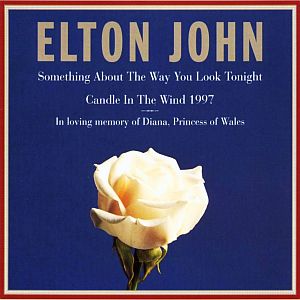
“Candle in the Wind 1997," Elton John’s tribute to Princess Diana at her passing, helped raise tens of millions for her foundation. Click for digital, CD, or vinyl.
In 2001, one month after the September 2001 attacks on the World Trade Center, John appeared at the Concert for New York City, where he performed a memorable version of “Mona Lisa and Mad Hatters”. Through the 2000s and 2010s, John has continued to lend his celebrity in support of various social causes around the world.
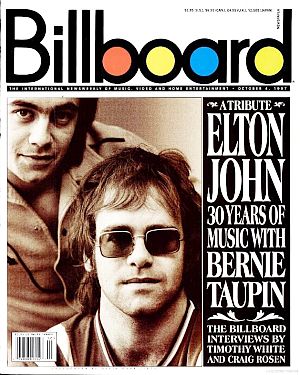
October 4, 1997. Billboard magazine cover and tribute story, “Elton John: 30 Years of Music With Bernie Taupin.”
Meanwhile, Elton John and Bernie Taupin have given the world an enormous musical legacy that will be enjoyed for many years into the future. After their frenetic success in the 1970s, Elton and Bernie took a two-year hiatus from each other (1979-1980), during which time they worked with other writers and artists. But not long thereafter, they resumed their partnership, co-writing several songs on the 1981 album, 21 at 33, and were back in full partnership by 1983’s Too Low for Zero album. Through the 1980s, 1990s and beyond they continued to pen many more songs.
Their work over the years has not only been musically appealing, but also bears a message or two here and there, defines personal feelings that have universal appeal, or offers a commentary on the times or the human condition. Millions of listeners who love the songs of Elton John have their own personal favorites, and listener polls, music magazine rankings, and sales data have identified a number of Elton John tunes regarded as most popular, most loved, most moving, etc..
Some of these have been the top hits, such as “Tiny Dancer,” “Levon,” “Rocket Man,” “Daniel,” and others. But also buried in the Elton John / Bernie Taupin oeuvre are songs that have not necessarily been pop hits, or even released as singles, but are nonetheless popular with listeners. Among these, might be, for example, “The Mona Lisas and Mad Hatters,” “Come Down in Time” (sampled earlier above), “Take Me to the Pilot”, “Razor Face” “My Father’s Gun”, “Border Song”, “Amoreena” (also sampled above), “Grey Seal”, “Funeral For a Friend”, and any number of others.
|
Goodbye Yellow Brick Road When are you gonna come down You know you can’t hold me forever So goodbye yellow brick road Back to the howling old owl in the woods What do you think you’ll do then Maybe you’ll get a replacement So goodbye yellow brick road Back to the howling old owl in the woods |
Yet, of all the songs Elton John and Bernie Taupin have penned together, perhaps few are more poignant than “Goodbye Yellow Brick Road,” sampled below. Among his platinum-level hits, and popular globally, this song was not as big a hit as “Tiny Dancer,” “Rocket Man,” “Levon,” or “Your Song.” Still, it is among those John/Taupin songs that many fans and music critics single out.
Music Player
“Goodbye Yellow Brick Road”
Elton John/ Bernie Taupin – 1973
The song and the album of the same name, use the phrase and iconic imagery from the 1939 film, The Wizard of Oz. There, and in other historic uses dating to the 1900s and the books of Frank Baum, upon which the film is loosely based, “the road of yellow bricks” has the implied meaning of a pathway upon which one might find some kind of reward, happiness, inner peace, and/or personal redemption. At least that is the seeming promise. It is also sometimes referred to as a metaphor for “the road that leads to life’s answers” or “the road that leads to life’s fantasies”.
In the film, of course, in the Land of Oz, it is the pathway to see the Wizard in the Emerald City. The Wizard is sought for his powers by Dorothy and her friends. But to make a long story short, the wizard doesn’t really have any special powers and he isn’t really a wizard.
The Wizard of Oz was reportedly the first film that Bernie Taupin had ever seen, and he used the imagery in the lyrics to relate to his own life. At the time he wrote “Goodbye Yellow Brick Road,” he wanted to live a more tranquil existence after experiencing the frenetic 1970s success he and John were having during the height of Elton John mania – a desire to get back to his roots; back, perhaps, to a more real world setting. No more “promised land” for him, say the lyrics; he prefers hearing the owls and ploughing the land over penthouse living and vodka and tonics.
Bernie Taupin’s lyrics in this song have the visceral power of nostalgia, of looking back, of longing for a past that is colored by the thought that, “yes, it was a better time back then.” And for many, that is a universal kind of sentiment. In addition, “the yellow brick road” imagery and concept, known to millions, is the perfect vehicle for innocent hope or nostalgic longing. And in this song’s delivery, Elton’s voice and the melody drive those kind of notions deep into the listener’s emotional core. Together, the song’s moving orchestral arrangement, along with Elton’s powerful vocals, elevate the lyrics to make this song a classic. Stewart Mason’s review of the song at AllMusic.com notes: “…Elton John’s “Goodbye Yellow Brick Road” is a small masterpiece of ’70s soft rock, and a strong contender for the coveted title of John’s finest song ever.”
Through the 1980s and 1990s the Elton John magic continued with more hit songs – among singles, for example, have been: “Little Jeanie” (#3 US, 1980); “I Guess That’s Why They Call it The Blues” (#4 US, #5 UK, 1983); “I’m Still Standing (#4 UK, #12 US, 1983); “Sad Songs Say So Much”(#5 US, # 7 UK, 1984); “Passengers” (#5 UK, 1984); “Nikita” (#3 UK, #7 US, 1985); “I Don’t Wanna Go on with You Like That”(#2 US, 1988); “Sacrifice (#18 US, 1989 / #1 UK 1990); “Don’t Let the Sun Go Down on Me” (with George Michael; #1 US & UK, 1991); “The One” (#9 US, #10 UK, 1992); “Can You Feel the Love Tonight”(#4 US, #14 UK); and, “Live Like Horses” (with Luciano Pavarotti; # 9 UK, 1996).Elton John and Bernie Taupin have been among most successful teams in popular music. They have collaborated on more than 30 albums. A total of more than 300 million Elton John records have been sold worldwide, making him one of the best-selling music artists of all time. To date, he has had more than fifty Top 40 hits, as well as seven consecutive No. 1 albums in the U.S., along with 58 Billboard Top 40 singles, 27 in the Top Ten, four at No.2, and nine at No.1. In his U.K. homeland he has scored 69 Top 40 singles, including 32 Top Tens and seven at No.1.
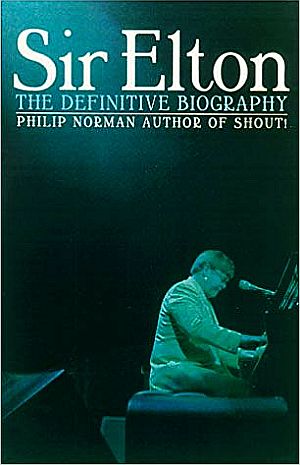
Philip Norman’s 2001 book, “Sir Elton: The Definitive Biography,” 592 pp, Carroll & Graf, publisher. Click for copy.
In fact, in the entertainment world, Elton John is distinguished as one of that rare group who have won an Oscar, a Grammy, and a Tony.
Over his career, he has been nominated for 34 Grammy Awards, winning six including, one honorary Grammy.
In film, he has been nominated for three Academy Awards, winning once for Best Original Song for “Can You Feel The Love Tonight” from The Lion King (1994). And in the theater, he has been nominated for four Tony Awards, winning once for Best Original Score in 2000 for Aida.
In addition to these, he has also five Brit Awards – two for Outstanding Contribution to Music and the first Brits Icon award in 2013 for his “lasting impact on British culture”. He has also won a Golden Globe Award, a Disney Legends award, and received the Kennedy Center Honor in 2004.
Elton John – make that “Sir Elton” – has also been knighted by Queen Elizabeth II for “services to music and charitable services.” In music, he was inducted into the Rock & Roll Hall of Fame in 1994. Ten years later, Rolling Stone ranked him at No. 49 on its 2004 list of 100 influential musicians of the rock and roll era. In 2018, Billboard placed him among the very top of successful solo artists on the Billboard Hot 100 – 3rd on the list of Top Artists of All Time, behind only the Beatles and Madonna and ahead of Elvis Presley. And there are still other awards, honors, collaborations, new Elton John ventures, and more. For further detail on these, see “Sources” below or visit his website at EltonJohn.com.
In October 2019, his autobiography, Me, Elton John, was published by Henry Holt & Co. (see below to order). The book became a best-seller and received good reviews. According to a New York Times review: “[Me] pushes the envelope…. The movie Rocketman gave a reasonably accurate overview of the Elton John story – but it barely scratched the surface of what’s in this memoir. The lurid parts will get all the headlines. But [it is really about] the man’s hard-won self-knowledge.”John’s 3-year farewell tour, begun in 2018, is slated to end in England in December 2020 after some 300 shows. But there will likely be a new Elton John song or two yet to come.
In any case, the music of Elton John – and especially those indelible John /Taupin creations of the 1970s – will live on well into the future.
See also at this website, “Candle in the Wind, 1973-1997,” about the Marilyn Monroe and Princess Diana songs that John and Taupin wrote, or check out the “Annals of Music” category page for additional stories that profile artists, song histories, and the music industry.
Thanks for visiting – and if you like what you find here, please make a donation to help support the research, writing and continued publication of this website. Thank you. – Jack Doyle
|
Please Support Thank You |
____________________________________
Date Posted: 31 May 2019
Last Update: 17 April 2020
Comments to: jdoyle@pophistorydig.com
Article Citation:
Jack Doyle, “Elton John’s Decade: 1970s (w/Bernie),”
PopHistoryDig.com, May 31, 2019.
____________________________________
Sources, Links & Additional Information
“Elton John,” in Holly George-Warren and Patricia Romanowski (eds), The Rolling Stone Encyclopedia of Rock & Roll, Rolling Stone Press, New York, 3rd Edition, 2001, pp. 500-502.
Robert Christgau, “The Little Hooker That Could,” The Village Voice, November 24, 1975.
Robert Christgau, “Elton John,” in Anthony De Curtis and James Henke (eds), The Rolling Stone Illustrated History of Rock & Roll, Random House, New York, 1992, pp. 528-531.
“The 1970s,” EltonJohn.com.
“Biography, Elton John,” 1994 Induction, Rock & Roll Hall of Fame.
“Elton John,” Wikipedia.org.
“Elton John, Chart History,” Billboard.com.
Ben Fong-Torres, “Elton John: The Four-Eyed Bitch Is Back; Elton Is Hard to Talk to When Anybody’s Around. By Himself, He’ll Talk,” Rolling Stone, November 21, 1974.
David Rensin,”Performance: Elton at the Hollywood Bowl, 9/7/73,” Rolling Stone, October 11, 1973.
“Elton John: Rock’s Captain Fantastic,” Time (cover story), July 7, 1975.
Matt Ballinger, “Times Critic Was Early Champion of Elton John,” L.A. Times Past/Tumbler.com, October 3, 2013.
Paul Sexton, “The Troubadour Nights That Changed Elton John’s Life; Why 25 August 1970 Was Such a Monumental Occasion in the Career of a Young English Singer-Songwriter,” uDiscoverMusic.com, August 25, 2018.
Elton John Interview, “A More Reflective Leap On Elton John’s ‘Diving Board’,” Fresh Air/ NPR.org, September 23, 2013.
Stephanie Zacharek, “A Glitter-Fueled Rocket-man Blasts Off, Time, June 3-10, 2019, pp. 93-95.
“Elton John: 20 Essential Songs,” The Tele-graph, October 20, 2015.
“Readers’ Poll: The Best Elton John Songs of All Time Your Picks Include ‘Levon,’ ‘Your Song’ and ‘Rocket Man’,” Rolling Stone, November 28, 2012.
“Elton’s First Shows in the U.S. – A Look Back,” EltonJohn.com, August 25, 2017.
“Bernie Taupin,” Wikipedia.org.
“Captain Fantastic and the Brown Dirt Cowboy,” Wikipedia.org.
“Madman Across The Water – BBC Sounds for Saturday, London, UK: 1971,” EltonJohn.com.
“Elton John 1970 World Tour,” Wikipedia .org.
“Elton John Tour Statistics,” SetList.fm.
“Border Song,” Wikipedia.org.
Cal Fussman, “Bernie Taupin: What I’ve Learned,” Esquire, January 2, 2012.
“Levon by Elton John,” SongFacts.com.
Tiny Dancer,” Wikipedia.org.
“Bernie Taupin Interview,” Billboard, October 4, 1997.
Mark Simonian, “Bowls Hollywood Over; Elton John ‘Puts On’ Concert,” The Stanford Daily, Volume 164, Issue 4, September 27, 1973.
Elton John’s 1979 Tour of the Soviet Union,” Wikipedia.org.
“1970s Decade Overview,” RockMusicTimeline .com.
“Photos: Elton John’s Outfits Through the Years; See All the Sunglasses, Animal Costumes and Chest Hair from 1973 On,” RollingStone.com, February 2, 2011.
Kimberley Dadds (BuzzFeed Staff, UK), “The 28 Most Flamboyant Elton John Stage Costumes Ever,” BuzzFeed.com, March 5, 2014.
Doug Fox, “Inside Elton John’s Historic Sold-Out Shows at Dodger Stadium,” Ultimate ClassicRock.com, October 25, 2015.
“Dodger Stadium 1975 – Game On!,” Elton John.com, August 28, 2018.
Marc Myers, “Bernie Taupin Tells the Story Behind 1972’s ‘Rocket Man.’ Inspired by Ray Bradbury’s Tale About an Astronaut, The Song Became an Unlikely Catch Phrase in Trump’s Tweets,” Wall Street Journal, April 4, 2018.
Dave Simpson, “Elton John’s 50 Greatest Songs, Ranked!,” TheGuardian.com(London), September 13, 2018.
Ed Power, “This One’s for You: The Story Behind Elton John’s Hit ‘Your Song’,” The Independent (London), November 15, 2018.
“The Boy & The Piano,” John Lewis Christmas Advert, 2018.
Roisin O’Connor, “John Lewis Christmas Ad: Elton John Tribute With ‘Your Song’ As Soundtrack Could Melt the Flintiest of Hearts,” The Independent (London), November 15, 2018.
Zack O’Malley Greenburg, “Elton John’s Retirement Tour Should Gross More Than $400 Million,” Forbes, January 24, 2018.
Jessica Napoli, “Elton John Reveals His Most ‘Difficult’ Scenes To Watch in ‘Rocketman’ Biopic,” Fox News, May 26, 2019.
Kristin Corpuz, “Elton John’s Biggest Billboard Hot 100 Hits,” Billboard.com, March 25, 2017.
Paul Sexton, “50 Years Of Diamonds From Elton John And Bernie Taupin,” uDiscover Music.com, January 24, 2018.
“Farewell Yellow Brick Road,” Wikipedia.org.
Hannah Taheri, “Top 10 Most Iconic Elton John Ensembles,” Golden1Center.com, Janu-ary 7, 2019.
Kathryn Vasel, “The World’s 10 Richest Recording Artists,” CNN Business, December 2, 2014.
Aisling Moloney, “What is Bernie Taupin’s Net Worth? Elton John’s lyricist Has Made a Serious Fortune,” MetroUK, November 13, 2017.
Ben Hirsh, “Does Elton John Really Live In Buckhead?,” Buckhead.com, May 4, 2016.
“Elton’s Photography Collection Now on Display at Tate Modern,” EltonJohn.com, November 10, 2016.
“Elton John Op-Ed on Tirelessly Fighting AIDS Through His Foundation: ‘We Have So Much Work Left to Do’,” (Cover Story), Billboard.com, October 15, 2015.
Stewart Mason, Song Review, “Elton John: Goodbye Yellow Brick Road,” AllMusic.com.
Rob Sheffield, “Elton John’s Greatest Non-Hits; For every “Rocket Man” or “I’m Still Standing,” There Are Countless Other Lost Gems Ripe For Rediscovery, From Stripped-Down Ballads to Decadent Glitter Epics,” Rolling Stone, February 2, 2011.
“Top 33 Forgotten / Overlooked Elton John Songs,” NeedSomeFun.net, July 4, 2017.
Billboard staff, “The Hot 100’s Top Artists of All Time,” Billboard.com, August 2, 2018.
__________________________


